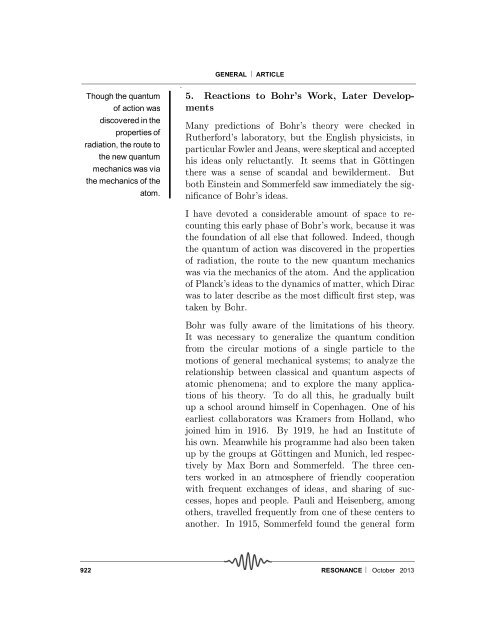Bohr and Dirac* - Indian Academy of Sciences
Bohr and Dirac* - Indian Academy of Sciences
Bohr and Dirac* - Indian Academy of Sciences
You also want an ePaper? Increase the reach of your titles
YUMPU automatically turns print PDFs into web optimized ePapers that Google loves.
GENERAL ARTICLE<br />
Though the quantum<br />
<strong>of</strong> action was<br />
discovered in the<br />
properties <strong>of</strong><br />
radiation, the route to<br />
the new quantum<br />
mechanics was via<br />
the mechanics <strong>of</strong> the<br />
atom.<br />
5. Reactions to <strong>Bohr</strong>'s Work, Later Developments<br />
Many predictions <strong>of</strong> <strong>Bohr</strong>'s theory were checked in<br />
Rutherford's laboratory, but the English physicists, in<br />
particular Fowler <strong>and</strong> Jeans, were skeptical <strong>and</strong> accepted<br />
his ideas only reluctantly. It seems that in GÄottingen<br />
there was a sense <strong>of</strong> sc<strong>and</strong>al <strong>and</strong> bewilderment. But<br />
both Einstein <strong>and</strong> Sommerfeld saw immediately the signi¯cance<br />
<strong>of</strong> <strong>Bohr</strong>'s ideas.<br />
I have devoted a considerable amount <strong>of</strong> space to recounting<br />
this early phase <strong>of</strong> <strong>Bohr</strong>'s work, because it was<br />
the foundation <strong>of</strong> all else that followed. Indeed, though<br />
the quantum <strong>of</strong> action was discovered in the properties<br />
<strong>of</strong> radiation, the route to the new quantum mechanics<br />
was via the mechanics <strong>of</strong> the atom. And the application<br />
<strong>of</strong> Planck's ideas to the dynamics <strong>of</strong> matter, which Dirac<br />
was to later describe as the most di±cult ¯rst step, was<br />
taken by <strong>Bohr</strong>.<br />
<strong>Bohr</strong> was fully aware <strong>of</strong> the limitations <strong>of</strong> his theory.<br />
It was necessary to generalize the quantum condition<br />
from the circular motions <strong>of</strong> a single particle to the<br />
motions <strong>of</strong> general mechanical systems; to analyze the<br />
relationship between classical <strong>and</strong> quantum aspects <strong>of</strong><br />
atomic phenomena; <strong>and</strong> to explore the many applications<br />
<strong>of</strong> his theory. To do all this, he gradually built<br />
up a school around himself in Copenhagen. One <strong>of</strong> his<br />
earliest collaborators was Kramers from Holl<strong>and</strong>, who<br />
joined him in 1916. By 1919, he had an Institute <strong>of</strong><br />
his own. Meanwhile his programme had also been taken<br />
up by the groups at GÄottingen <strong>and</strong> Munich, led respectively<br />
by Max Born <strong>and</strong> Sommerfeld. The three centers<br />
worked in an atmosphere <strong>of</strong> friendly cooperation<br />
with frequent exchanges <strong>of</strong> ideas, <strong>and</strong> sharing <strong>of</strong> successes,<br />
hopes <strong>and</strong> people. Pauli <strong>and</strong> Heisenberg, among<br />
others, travelled frequently from one <strong>of</strong> these centers to<br />
another. In 1915, Sommerfeld found the general form<br />
922 RESONANCE October 2013
















